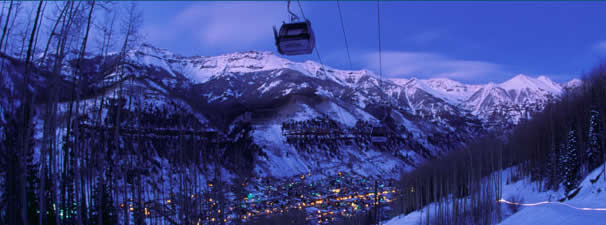|
Telluride
Gondola

The Gondola makes Telluride even more unique as it connects Telluride and Mountain Village with an environmental sound transportation option. During your next Telluride vacation be sure to check out the Gondola.
Operating Dates and Times
Open 275 days/year, 7:00 a.m - Midnight.
During certain events, like major festivals, the gondola will sometimes stay open later to accommodate guests going from Telluride to their lodging in Mountain Village.
For the 2009 Spring off-season, the Gondola will be closed until May 22nd. The gondola remains open during the summer and closes for the 2009 Fall off-season between October 18th and November 20th.
During the off-seasons, a bus service is available between Telluride and Mountain Village, operated by the Town of Mountain Village.
Riding Time Stats
Leg 1 = 6.2 minutes
Station Telluride to Station St. Sophia
Leg 2 = 4.7 minutes
Station St. Sophia to Station Mountain Village
Leg 3 = 1.2 minutes
Station Mountain Village to Station Village Parking
Passengers may ride in the same gondola cabin between Station Telluride and Station Mountain Village, however, passengers must disembark to ride between Station Mountain Village and Station Village Parking. A lift ticket or season pass is required to disembark at Station St. Sophia and access the mountain during the ski season.
Environment Matters
The gondola virtually eliminates noise and air pollution, congested parking lots, and the need for people to drive their vehicles between the two towns. It simultaneously provides clean, smooth, quiet, free and visually spectacular transportation. The gondola towers are low profile, usually not exceeding tree line, lessening the visual impact typical of gondolas while also dramatically reducing the likelihood of shut down due to high winds.
Convenience
With a total of 59 eight-passenger gondola cabins on the three lines (26 on legs 1 & 2 and six on leg 3), guests can step into a gondola cabin almost every minute. Commuting this way takes far less time than riding the old intratown bus system. The hourly capacity of the gondola is 600% greater than the bus system. (The total hourly capacity of the gondola is 930 people per hour between towns in both directions while the total hourly capacity of the bus is 80 pph in both directions.) The gondola can handle up to 1200 pph if consistent demand in the future warrants more cabins being added.
Other Fast Facts
Terminal Names: Station Telluride, Station St. Sophia, Station Mountain Village, Station Village Parking
Passengers: Maximum eight passengers per cabin. Mountain bikes can be carried on some cabins during the summer and all cabins have ski/snowboard racks in the winter. All cabins are handicap and pet friendly as well.
The Chondola: (Also known as Lift 1) is a high speed quad chairlift with four passenger gondola cabins providing access from the Mountain Village core to the Meadows Area. The gondola cabins are free to the public but skiers and boarders are required to have a lift ticket. The Chondola does not run during the summer. The base is located adjacent to Big Billies Restaurant and Apartments in the Mountain Village and the chondola's top station is a 100-yard ski or walk from Station Mountain Village and Lift 4.
System builders: CTEC of Salt Lake City and Garaventa of Switzerland
Length: 2 1/2 Miles (4 kilometers)
For several years, the Telluride Ski & Golf Company (Telski) worked diligently to build the first-of-its-kind $16 million public transit system intended to eliminate the transportation and air quality impact of growth in the region. The first part of the system, the Chondola (a high-speed quad with a 4-person gondola cabin every 10th chair), opened in the 1995/96 season. The gondola, joining the historic town of Telluride with the town of Mountain Village and serving several ski runs, opened in November of 1996.
Today, the gondola between Telluride and Mountain Village is funded by the Town of Mountain Village tax payers, through their owners organization: Telluride Mountain Village Owners Association. The Town of Mountain Village manages the daily operations of the gondola.
Telluride's gondola is the equivalent of three high-speed express lifts. While it transports skiers and snowboarders to a mountain ridge, it is primarily a public transportation system and it's free to foot passengers. It virtually eliminates the need for a car and drastically reduces the amount of air and noise pollution. It eliminates growing traffic congestion and subsequently increases safety. It provides residents with an easy commute to work or school and allows guests to avoid renting a car. Most remarkably, it is more convenient and timely than a bus, a car or even light-rail.
Mass Frenzy Versus Mass Transit
No worries with rental cars, parking, driving on snowy roads or long, cold waits for the bus. All typical resort transit problems are solved. It's a taxi on demand running from 7:00 a.m.-11:00 p.m. (midnight Fri. and Sat.)
Environment Matters
Telluride's gondola offers tremendous environmental benefits by mitigating transportation impacts and growth caused by the region's residents. The system significantly reduces noise and air pollution, parking demands and the need for people to drive their vehicles between the two towns. It simultaneously provides clean, smooth, quiet and visually spectacular transportation. The gondola towers are low profile, usually not exceeding any tree line, decreasing the visual impact associated with typical gondolas while dramatically reducing the likelihood of closure due to high winds.
The Most Beautiful Commute in America
The gondola provides transportation between towns for people commuting to work, going to the grocery store or meeting friends, easing the burden of traffic between the towns. Beginner skiers and snowboarders can reach beginner terrain without the hassle of a car or bus. Parents can transport their kids to Children's Ski School in the morning. Local kids can ride it to and from school. All of this eliminates the need for vehicles between the two towns during the gondola's operating hours, thereby reducing air pollution and noise, and providing a much safer mode of winter transport.
|


